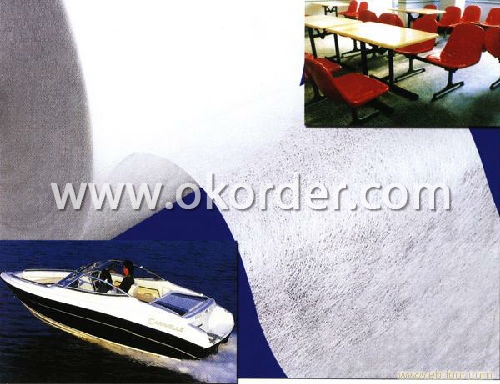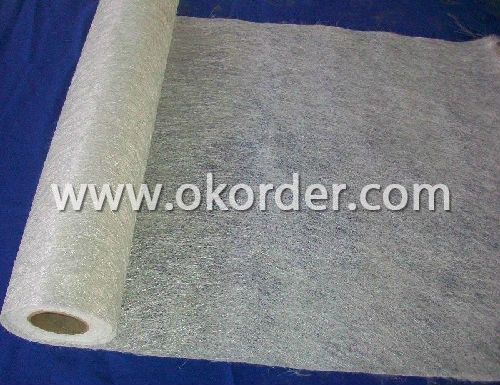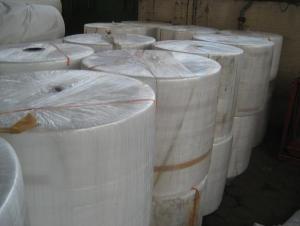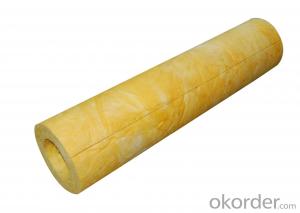Tissue Mat
- Loading Port:
- China Main Port
- Payment Terms:
- TT or LC
- Min Order Qty:
- 2000Square Meter m²
- Supply Capability:
- 60000 Square Meter Per Month m²/month
OKorder Service Pledge
OKorder Financial Service
You Might Also Like
Packaging & Delivery of Tissue Mat
| Packaging Detail: | Carton |
| Delivery Detail: | 20Days |
Specifications of Tissue Mat
GSM: 20g/m2 to 280g/m2
Wdith: 1m to 2.1m
Max Roll Length: 3800m/Roll
Characteristics of Tissue Mat
It is made with water-dispersed chopped strands by wet technic and has being our strong product for export in the past decade. The width of finished product is 1m, 2m or 2.06m and length is 50m, 100m, 300m, 500m, 1500m, 2800m, 3600m, 3700m, or 3800m/roll. We also can cut it into the tape of width 30mm, 50mm, 100mm or 200mm and length 25m or 100m/roll. The area weight is 20g/m2, 25g/m2, 30g/m2, 45g/m2, 50g/m2, 60g/m2, 70g/m2, 80g/m2, 90g/m2, 100g/m2, 260g/m2 or 280g/m2.
As per clients’ application, we also can supply the following products.
1.fiberglass roofing tissue with or without 66 yarns (45g/m2, 50g/m2, 60g/m2, etc)
2.fiberglass surface tissue for FRP products
3.fiberglass tissue for pipe wrapping
4.PVC floor tissue (such as 40g/m2 x 2.06m width x 2800m/roll)
5.Fiber glass mat (CCL CEM-3 using)
6.AGM battery separator tissue
Meantime, we also can process some new products as per clients’ specical requirement, pls. see them as follows:
1.colorful tissue (yellow, red, blue, etc)
2.fiberglass tissue with one side coating of cement (the base tissue is 30g/m2~45g/m2 and coating is 15g/m2. The finished product is fire-proof and heat-resistant).


- Q:Can fiberglass mat tissue be used for repairing fiberglass boats?
- Yes, fiberglass mat tissue can be used for repairing fiberglass boats. Fiberglass mat tissue is a versatile material that is commonly used in repairing and reinforcing fiberglass structures, including boats. It is designed to provide strength and durability, making it an ideal choice for patching holes, cracks, or damaged areas in fiberglass boat hulls. The mat tissue is typically layered with resin to form a solid and stable repair, ensuring that the boat remains structurally sound. Additionally, fiberglass mat tissue is easy to work with and can be cut to the desired size and shape, making it suitable for various repair applications on fiberglass boats.
- Q:Can fiberglass mat tissue be used for waterproofing?
- Indeed, fiberglass mat tissue has the potential to be utilized for waterproofing purposes. This particular material, comprised of fiberglass fibers, takes the form of a thin, non-woven substance. Its primary function lies in the reinforcement and provision of waterproofing attributes within the realm of construction and building applications. When combined with a waterproofing agent or resin, the fiberglass mat tissue can establish an impermeable barrier, effectively impeding the infiltration of water or moisture. Consequently, it proves to be a highly advantageous option for various undertakings such as roofing, basement waterproofing, and the installation of bathrooms or showers. Furthermore, the robustness and enduring nature of fiberglass mat tissue contribute to its resistance against cracks or tears, guaranteeing the longevity of its waterproofing capabilities.
- Q:How is fiberglass mat tissue used in the production of storage sheds?
- Fiberglass mat tissue is used in the production of storage sheds to reinforce the structure and provide added strength and durability. It is typically applied as a layer in the construction process, serving as a reinforcement material for the shed's walls, roof, and floor. The fiberglass mat tissue helps to prevent cracking, increase resistance to weather elements, and improve overall longevity of the storage shed.
- Q:How does the roll weight of fiberglass mat tissue affect its transportation?
- The roll weight of fiberglass mat tissue can have a significant impact on its transportation process. The weight of the roll determines the ease of handling and the logistics required for transportation. Firstly, a heavier roll weight can make it more challenging to move and handle the fiberglass mat tissue. If the roll is too heavy, it may require specialized equipment or machinery for loading and unloading, such as forklifts or cranes. This can add complexity and cost to the transportation process. Moreover, the weight of the roll also affects the packaging and storage requirements during transportation. Heavier rolls may require sturdier packaging materials and additional precautions to ensure their stability and prevent any damage during transit. This can include using pallets, strapping, or other securing methods to prevent the roll from shifting or falling during transportation. The weight of the roll also impacts the overall cost of transportation. Heavier rolls can increase shipping costs, as carriers often charge based on weight. Additionally, the weight of the roll can affect the number of rolls that can be transported in a single shipment, which can impact the efficiency and cost-effectiveness of the transportation process. In summary, the roll weight of fiberglass mat tissue plays a crucial role in its transportation. It affects the ease of handling, packaging requirements, and overall cost of transportation. Therefore, it is essential to consider the roll weight when planning and organizing the logistics for transporting fiberglass mat tissue.
- Q:How does fiberglass mat tissue compare to other types of reinforcement materials?
- Fiberglass mat tissue is a type of reinforcement material that is commonly used in various industries such as construction, automotive, and marine. When comparing fiberglass mat tissue to other types of reinforcement materials, several factors come into play. Firstly, fiberglass mat tissue offers excellent strength and durability. It has high tensile strength, meaning it can withstand considerable pulling or stretching forces without deforming or breaking. This strength is comparable, if not superior, to other reinforcement materials like carbon fiber or aramid fibers. Additionally, fiberglass mat tissue has good resistance to chemical, moisture, and UV degradation, making it suitable for long-term use in various environments. Another advantage of fiberglass mat tissue is its cost-effectiveness. Compared to other reinforcement materials, fiberglass is relatively inexpensive, making it a popular choice for manufacturers and builders who require a cost-efficient solution without compromising on quality. Its affordability makes it accessible to a wider range of applications and industries. Furthermore, fiberglass mat tissue is known for its versatility. It can be molded into various shapes and sizes, allowing for customization and flexibility in design. This adaptability makes fiberglass mat tissue suitable for a wide range of applications, from simple repairs to complex structural reinforcements. However, it is worth noting that fiberglass mat tissue may have some limitations compared to other reinforcement materials. For instance, it may not have the same level of stiffness or strength as carbon fiber, which is often preferred in high-performance applications. Additionally, fiberglass mat tissue may have lower resistance to impact or fatigue compared to materials like aramid fibers. In conclusion, fiberglass mat tissue offers a combination of strength, durability, cost-effectiveness, and versatility that makes it a favorable choice for many applications. While it may have some limitations compared to other reinforcement materials, its overall performance and affordability make it a widely used and reliable option in various industries.
- Q:What are the different methods of bonding fiberglass mat tissue to other materials?
- There are several methods of bonding fiberglass mat tissue to other materials, each with its own advantages and considerations. Some of the common methods include: 1. Mechanical Bonding: This method involves physically interlocking the fiberglass mat tissue with the other material. It can be achieved through techniques such as stitching, stapling, or using mechanical fasteners like screws or nails. Mechanical bonding provides a strong and durable connection, but it may require additional hardware and can be time-consuming. 2. Adhesive Bonding: Adhesive bonding is a popular method that uses adhesives or glue to join the fiberglass mat tissue with the other material. This method offers flexibility, as there are various types of adhesives available for different applications. It is important to choose an adhesive that is compatible with both the fiberglass mat tissue and the other material. Proper surface preparation and application techniques are crucial for achieving a strong bond. 3. Resin Infusion: Resin infusion is a process where a liquid resin is infused into the fiberglass mat tissue and other materials, creating a strong bond when cured. This method is commonly used in manufacturing composite products, as it allows for a seamless and uniform bond. Vacuum bagging or resin infusion techniques are typically employed to ensure proper resin distribution and consolidation. 4. Thermal Bonding: Thermal bonding involves the use of heat to bond the fiberglass mat tissue to another material. This method is particularly suitable for thermoplastic materials, as they can be softened and fused together with heat. Techniques such as heat welding or ultrasonic welding are commonly used for thermal bonding. It is important to ensure that the heat does not damage or degrade the fiberglass mat tissue during the bonding process. 5. Fusion Bonding: Fusion bonding is a method where the fiberglass mat tissue and the other material are heated to a molten state and then brought into contact to form a bond. This technique is commonly used in the manufacturing of thermosetting plastics or joining thermoplastic materials. Fusion bonding can provide a strong and seamless bond, but it requires careful control of temperature and pressure to ensure proper bonding without causing damage. In summary, the different methods of bonding fiberglass mat tissue to other materials include mechanical bonding, adhesive bonding, resin infusion, thermal bonding, and fusion bonding. The choice of bonding method depends on factors such as the materials being bonded, the desired strength and durability, and the specific application requirements.
- Q:Does fiberglass mat tissue require any special maintenance after installation?
- No, fiberglass mat tissue does not require any special maintenance after installation.
- Q:Does fiberglass mat tissue require any special precautions during storage?
- Yes, fiberglass mat tissue does require special precautions during storage. It should be stored in a dry and well-ventilated area to prevent moisture damage. Additionally, it should be kept away from direct sunlight and extreme temperatures as they can degrade the material. Proper stacking and support should also be ensured to prevent any deformation or damage.
- Q:Can fiberglass mat tissue be used for flooring applications?
- For flooring applications, fiberglass mat tissue is a viable option. Composed of glass fibers, this thin, non-woven fabric offers a lightweight and flexible solution. Its exceptional strength and durability further contribute to its suitability for diverse flooring uses. To reinforce flooring systems like vinyl or linoleum, fiberglass mat tissue can serve as a layer of support. By preventing cracking or warping, it adds strength and stability. Typically, the mat tissue is embedded in adhesive or resin, establishing a robust bond between the flooring material and the subfloor. Furthermore, fiberglass mat tissue can function as an underlayment during flooring installations. It acts as a barrier between the subfloor and the flooring material, providing insulation, soundproofing, and moisture resistance. This protective measure safeguards against moisture damage, reduces noise transmission, and maintains a comfortable indoor environment. In summary, fiberglass mat tissue is a versatile material that enhances flooring applications. Its strength, flexibility, and moisture resistance make it suitable for various flooring systems, offering improved stability, durability, and comfort.
- Q:How thick is fiberglass mat tissue typically?
- Fiberglass mat tissue, also known as fiberglass mat or simply mat, typically comes in various thicknesses depending on its intended use. The thickness can range from 0.5 millimeters (mm) to as thick as 3 mm. However, the most commonly used thicknesses for fiberglass mat tissue are 1.5 mm and 2 mm. These thicknesses are ideal for applications such as reinforcing laminates, composite materials, and providing surface finishes. It is important to note that the specific thickness of fiberglass mat tissue may vary depending on the manufacturer and the specific requirements of the project.
1. Manufacturer Overview |
|
|---|---|
| Location | Hebei,China |
| Year Established | 2008 |
| Annual Output Value | Above US$20 Million |
| Main Markets | Mid East;Western Europe:South Asian |
| Company Certifications | ISO9001:2000;ISO14001:1996;GB/T28001:2001 |
2. Manufacturer Certificates |
|
|---|---|
| a) Certification Name | |
| Range | |
| Reference | |
| Validity Period | |
3. Manufacturer Capability |
|
|---|---|
| a)Trade Capacity | |
| Nearest Port | Tianjin |
| Export Percentage | 80% |
| No.of Employees in Trade Department | 350 People |
| Language Spoken: | English;Chinese;Korean |
| b)Factory Information | |
| Factory Size: | Above 100,000 square meters |
| No. of Production Lines | Above 12 |
| Contract Manufacturing | OEM Service Offered;Design Service Offered |
| Product Price Range | Average |
Send your message to us
Tissue Mat
- Loading Port:
- China Main Port
- Payment Terms:
- TT or LC
- Min Order Qty:
- 2000Square Meter m²
- Supply Capability:
- 60000 Square Meter Per Month m²/month
OKorder Service Pledge
OKorder Financial Service
Similar products
New products
Hot products
Hot Searches
Related keywords



























